INTERESTING BEHAVIORS
SOME INTERESTING BEHAVIORS (AND CONDITIONS) IN BIRDS (Images below)
This page contains descriptions and photos – with links to articles or videos – of some interesting behaviors in birds:
ALIGNING FOOD
ANTING
BROKEN WING TACTIC
CRECHING
DRUMMING
FIGHTING
FLUFFING
IMPRINTING
LEUCISM
MURMURATION
PARASITISM
SHELL-CRACKING
SLEEP
SUNBATHING (OR SUNNING)
YAWNING
ALIGNING FOOD
Birds have a vast diversity of bill shapes and sizes, which allow them to capture their prey and pick their food according to their diet in the environment where they live. Their tongues too are specialized for the same reason.
The photos below appear to show the capacity for birds to neatly align their prey – or food – in their bills, in such a way that it takes less space. They can ‘optimize their bill holding capacity’ this way. To better appreciate that behavior, please click on the + sign on the photo to enlarge it.
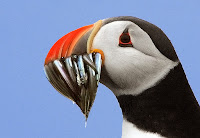 |
| 'Back from fishing trip' Atlantic puffin with sand eels, by Steve Garvie |
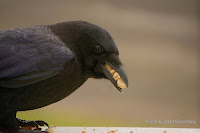 |
| American crow stuffing up on peanuts by Matt Beardsley, PEI, Canada |
 |
| Dark-eyed junco with caterpillars, by Kathy McCormack, PEI, Canada |
Grackles and Jays, as well as the Northern Flicker, are known to practice ‘anting‘, i.e. rubbing ants on their bodies. It is not known exactly why birds do this, but one explanation would be that they use the formic acid from ants as a pesticide to get rid of parasites. Another explanation would be to rid the ants of their formic acid before eating them (as a ‘thank you’ after they cleaned their feathers).
BROKEN WING TACTIC
Some bird species are known to use the ‘broken wing tactic‘ to try and distract a potential predator away from their nest. The Killdeer is a good example of that strategy (distraction display):
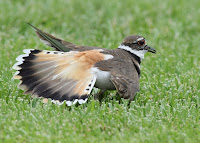 |
| Killdeer faking injury, by Andy Reago and Chrissy McClarren |
CRECHING
This term comes from the French word ‘crèche’, which refers to a day care center for young children, and also the Nativity scene. Creching is an animal behavior observed in birds and other animals.
In birds, it is mainly associated with the species that breed in colonies, such as Canada Geese, penguins or Common Eiders. Mother birds will lead their young in large groups and will take care of all the birds together, even those that are not their own in the group.
So far it seems that the record of the ‘Mother’ of all mothers would be a Common Merganser with a creche of SEVENTY-SIX ducklings!!
A similar behavior is called ‘Communal Brooding’, where the chicks of several nests close by are raised by all their parents. California Quails practice that rearing method sometimes.
 |
| Canada goose creche, by Robert Lawton |
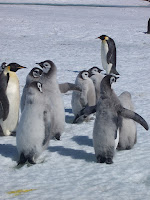 |
| Emperor penguins creche by Matthieu Weber |
How can a woodpecker drum repeatedly on hard surfaces without sustaining brain damage? There is a study trying to answer that question. Researchers found that woodpeckers can peck millions of times in their lifetime without any apparent brain damage. Yet, the acceleration force (Gs) of their pecking is in the 1,300 range. Compare this with a force of only 80 Gs sustained by a human, which will result in a brain concussion! Here’s a video below of a Northern Flicker drumming.
FIGHTING
There are various reasons why birds will fight or squabble. It can be to defend a territory against rivals and predators. It can be for a mate, or to establish dominance in a colony. This is called ‘pecking order’, and this behavior was first observed in chickens. The establishment of a kind of hierarchy in a group has many survival qualities for the species.
Birds can also squabble over a source of food, or they can fight for ‘fun’, just like young mammals do. The photos below illustrate this fighting behavior, although the cause is not known. Note the deadly power of the eagles’ talons.
 |
| Bald eagle juvenile sparring with an adult, by Isobel Fitzpatrick, PEI |
 |
| Blue jays squabbling, by Wanda Bailey |
Birds fluff their feathers for all kinds of reasons. They do this when they are relaxed and sleepy. Another one is when they are sick. But they also do it to keep warm. Fluffing their feathers creates air pockets in them which act as an insulation that helps them keep warm. This behavior is especially important during the winter. There are also other adaptations by birds to survive the long and cold Canadian winters, such as : going into hypothermia at night and huddling together like chickadees, or storing extra seeds into a pouch like the redpoll, and then digesting them slowly. Here are some examples of fluffy birds below.
 |
| Fluffy American goldfinch, Wanda Bailey |
 |
| Mourning dove fluffing its feathers to keep warm, by Marie Smith |
Imprinting is the attachment of a young animal at birth to a mother figure. It has been studied extensively on geese by Konrad Lorentz. An unusual case of inter-species imprinting has taken place between bald eagles (parents) and a red-tailed hawk (presumably brought to the eagles’ nest as food for their chicks). It turned out very differently however.
LEUCISM
Leucism comes from ‘white’ in Greek, and refers to a condition in birds (and other animals too) where their feathers have less color pigmentation and may appear much lighter or ‘washed out’. It is a genetic trait used in captive breeding, such as for white peacocks. How do such birds survive in the wild however is a different matter. For predators such as hawks, not having camouflage plumage will make it difficult to hunt prey. Leucism also makes the birds more vulnerable to predators, as they are much more visible.
Aside from complete leucism, sometimes birds can display white spots in their plumage, such as this Common Grackle below (also captured by Lois Kilburn).
 |
| Leucistic Black-capped chickadee, by Lois Kilburn, PEI, Canada |
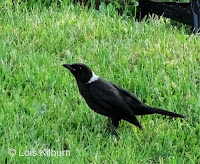 |
| Common grackle with white spot on nape, by Lois Kilburn, PEI, Canada |
 |
| Leucistic Red-tailed hawk, by Brett MacKinnon, PEI, Canada |
A ‘murmuration’ is a unique display of evolving aerial shapes in the sky by a group of birds, mostly European Starlings, as they change direction en masse while flying. Many photos and videos are available online illustrating this phenomenon, more frequent in the fall and before sunset, before roosting for the night. There are now even paragliders flying into murmurations. Another species is also known for spectacular murmurations in Australia, the Budgerigar (or Budgie, the highly popular pet parakeet).
The most frequent explanation to this behavior is protection from predators. However on the flip side it’s a risk to aircraft – and for drivers on a highway or a bridge, a distraction.
Here are some interesting articles about murmurations:
https://www.allaboutbirds.org/how-do-starling-flocks-create-those-mesmerizing-murmurations/
http://www.isciencetimes.com/articles/6725/20140123/murmuration-starlings-dance-sky-perfect-unison.htm
This video below shows a starling murmuration above the Hillsborough bridge on Dec. 27, 2014:
PARASITISM
Some bird species have parasitic behaviors, which have various degrees of impact on other species. One well-known example is ‘brood parasitism‘, where a bird species will lay its eggs in the nest of another species. The Brown-headed Cowbird is an ‘obligate’ parasitic species, which means that it always lays its eggs in other species nests, and never builds its own nest. An example of an occasional brood parasite is the Yellow-billed Cuckoo, that sometimes lays its eggs in the nest of a related species, the Black-billed Cuckoo.
Another type of parasitism in birds is called ‘kleptoparasitism’, where the bird feeds by stealing food catched by other species. (The name comes from Greek ‘klepto’, to steal – think ‘kleptomania’.) Many large seabirds behave this way, for example the Bald Eagle, frigatebirds, jaegers and skuas. These birds will chase their targets in flight and force them to release or disgorge their prey.
 |
| Eastern phoebe nest with Brown-headed cowbird egg, by Gaawebdesign |
A well-known study (The Development of Shell-cracking Behavior in Gulls) has provided information on the shell-cracking behavior of gulls. It has been noticed for a long time that gulls will drop shells from a height to the ground in order to crack them up and eat the contents.
Older gulls are more successful in cracking shells, by learning to drop them from just the right height and dropping them on hard surfaces such as asphalt and rocks rather than on sand or mud. One area I know of where dozens of cracked open shells can be found is along the road to Robinson’s Island in the PEI National Park.
This is apparently a learned behavior and it is not peculiar to just gulls, as crows are known to do it as well, and to not just using rocks to crack open the source of food. There are videos on YouTube showing crows using traffic to crack up nuts for example, such as here and here. Some of those crows are even smart enough to drop their nuts in pedestrian crossing areas, and then wait for the green light to collect their food!
Even a thrush can crack a shell, such as this one using a rock to crack open a snail shell . There are also many videos on YouTube of gulls using that feeding behavior. Here’s a photo below of a Black-legged Kittiwake, a species of gull, carrying a mollusc in the air for dropping. The photographer observed several of those gulls doing this, and that they seemed to estimate the optimal height from which to drop the shells.
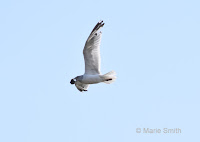 |
| Black-legged kittiwake carrying mollusc for dropping to crack up the shell by Marie Smith, Summerside, PEI |
SLEEP
The four Sanderlings below sleeping near the edge of the waterare standing on one leg, a position frequently used by birds. Resting on one leg apparently helps birds conserve heat, as their legs have no feathers. Birds will also tuck their bill under a wing when sleeping.
However in the case of the four sanderlings, another behavior can be observed while they’re ‘sleeping’ – three of them (at least the ones we can see) have one eye open. This is likely showing ‘unihemispheric slow-wave sleep’ (USWS), a behavior which allows some birds to have half their brain asleep while the other is awake. This has obviously a high survival value, as a bird with such a sleep feature can check for predators while resting. Apparently some birds also use USWS in migratory flights, but the latter needs more studying. Here’s an example below of this type of sleep:
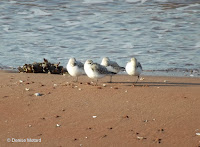 |
| Four Sanderlings sleeping with one eye open, Brackley Beach, PEI |
SUNBATHING (OR SUNNING)
Birds are known to expose their feathers to the sun, for example to regulate their temperature but also to spread their preening oil evenly on their feathers and to kill parasites. Here’s a photo of a Great Blue Heron in a sunning posture:
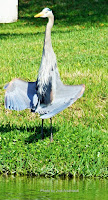 |
| Great blue heron sunning TX, by Jodi Arsenault |
YAWNING
Birds also yawn, and it seems to be used to regulate their body temperature. Here are some examples:
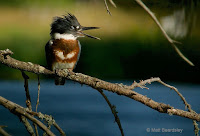 |
| Belted Kingfisher juvenile female Aug. 5, 2017, © Matt Beardsley |
 |
| Barred owl yawning, Quebec, by Cephas |